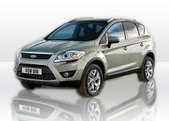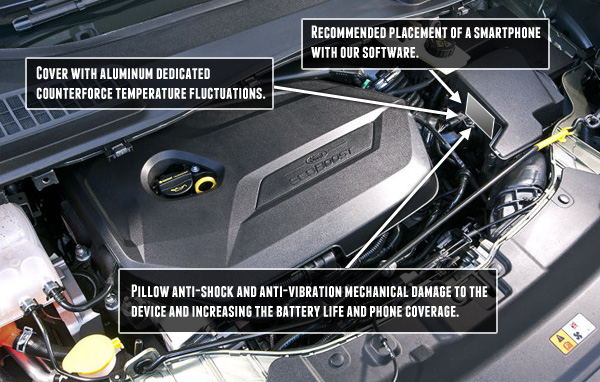
Ford KUGA GPS Tracking
Track your KUGA for free and visualize it on map
Produced to: NOW
How to track your favourite Ford - model KUGA in realtime for free ?
Producer remarks about this particular model
This compact crossover SUV was designed according to Ford "Kinetic Design" philosophy. Both front-wheel drive and four-wheel drive are offered, each with a choice of 2.5-litre petrol or 2.0-litre diesel engine.Our product description
We are offering you completely free of charge our GPS car tracking solution in real time. The only thing you need to do is to install smartphone with Android inside your vehicle with our awesome application on board
If you want to track your Ford KUGA in real time you have to do the following :
1. Download Free Car Tracking Application for KUGA application from Google Play
2. Create free account on spysat.eu (for example johndoe) - here is detailed instruction
3. Define Device endpoint for each vehicle you want to track - give friendly name of your KUGA and PIN (some random will be provided - you can change it if you want)
4. Run SpySat mobile application on the smartphone and type there your LOGIN from SpySat (ex. johndoe) and PIN (from point 3.)
5. Install your smartphone inside the car
6. Enjoy watching position of your car at spysat.eu site.
7. Provide stable power supply - spysat app consumes some energy.
Best options to install smartphone inside Ford KUGA

Our scientists, based on recent studies have developed optimal placement of tracking devices. It turned out that the fuel pump in this particular model, causes a significant shock. To prevent damage to the machine, put them in a special housing. It will protect your device from damage.
To permanently mount a smartphone in your Ford KUGA with a direct connection to the battery, follow these steps:1. First, ensure that your phone is waterproof or has an additional case that will protect it from potential water damage during the installation process.
2. Locate the battery compartment of your Ford KUGA and remove any screws necessary to access the area. Be cautious not to damage the electrical components or the wiring.
3. Cut a piece of sturdy 3M tape or adhesive foam padding (approximately 6 inches by 2 inches) for use as an anchor point. Make sure it's large enough to securely hold your phone in place.
4. Attach the 3M tape or adhesive foam padding inside the battery compartment, positioning it near the bottom and angled upwards slightly so that it can be easily removed later.
5. Place your smartphone on top of the adhesive pad, ensuring that it is centered and level. Press down firmly to secure it in place.
6. Reinstall the battery compartment by replacing any screws you removed earlier and tightening them securely to maintain a tight seal.
7. To establish a permanent direct connection between your phone and Ford KUGA's battery, you can use Bluetooth or WiFi tethering from your smartphone. Alternatively, you may also consider using an external portable Wi-Fi hotspot device to create a wireless connection.
8. Download and install our free GPS Tracker App (available on this website). Once installed, set up the app according to your preferences and start using it for GPS tracking purposes.
9. For regular maintenance tips specific to your Ford KUGA model: Refer to the owner's manual or consult with a trusted mechanic or automotive expert.
Please be aware that permanent installation of a smartphone may require additional considerations, such as ensuring proper airflow around the device and avoiding extreme temperatures or moisture levels. Always exercise caution when working on electrical components and refer to your Ford KUGA's owner's manual for any specific instructions or warnings.
Users opinions and questions
Kuga was / was a positive surprise of Ford, so it's good that preparing the second generation, not zepsuto what did not require repair and fixed what actually advent of. So in one sentence - still stylistically interesting and new sizes more entertaining use of this model.
Frequently Asked Questions:
How can you compare the performance and fuel efficiency of different engine options available on a 2018 Ford Kuga, and which one is recommended for an urban driver's daily commute?
To compare the performance and fuel efficiency of different engine options available on a 2018 Ford Kuga, you can refer to the manufacturer's specifications. The 2018 Ford Kuga comes with three engine choices: 1.5-liter EcoBoost, 2.0-liter TDCi, and 2.5-liter Duratec.The 1.5-liter EcoBoost produces 170 horsepower and has a combined fuel consumption of 47.9 mpg (1.86 l/100km) according to the manufacturer's specifications. The 2.0-liter TDCi engine produces 148 horsepower and has a combined fuel consumption of 57.6 mpg (4.55 l/100km). The 2.5-liter Duratec engine produces 163 horsepower and has a combined fuel consumption of 39.2 mpg (7.11 l/100km).
For an urban driver's daily commute, the 1.5-liter EcoBoost engine is recommended as it offers a good balance between performance and fuel efficiency. The 2.0-liter TDCi engine may be more suitable for drivers who prioritize fuel efficiency over performance, while the 2.5-liter Duratec engine might be better suited for those who require more power and are not as concerned about fuel consumption. However, it's also essential to consider factors such as driving style, personal preferences, and specific road conditions when choosing the best engine option for your daily commute.
Can you explain the differences between the 2017 and 2018 models of Ford Kuga, particularly focusing on engine performance and available safety features?
Yes, I can provide a comparison between the 2017 and 2018 models of Ford Kuga.In terms of engine performance, both the 2017 and 2018 models of Ford Kuga offer similar options. However, the 2018 model features an upgraded 2.0-liter EcoBoost engine option that produces more horsepower (245 hp) than the previous version's top engine option (240 hp). Additionally, the 2018 Kuga introduces a new 4x4 all-wheel drive system for improved traction and handling.
As for available safety features, both models come standard with Ford's MyKey system, which allows parents to set speed limits and other restrictions for young drivers. However, the 2018 Kuga adds several new safety features as well, including:
- Pre-Collision Assist with Pedestrian Detection - This system uses radar and camera technology to detect potential collisions with other vehicles or pedestrians, and can apply the brakes automatically if it senses an imminent crash.
- Adaptive Cruise Control with Stop-and-Go and Lane Centering - This feature allows the vehicle to maintain a set distance from the car in front of it, even coming to a complete stop if necessary. It also helps keep the car centered in its lane using steering adjustments.
- Evasive Steering Assist - When the driver rapidly changes direction to avoid a collision with a vehicle or pedestrian, this system can provide additional steering assistance to help the driver complete the evasive maneuver.
Overall, while both models of Ford Kuga offer similar engine performance options, the 2018 model includes several new safety features designed to improve driver and passenger protection on the road.
As a Ford car salesman, can you explain the key differences between the previous and current generations of Ford Kuga in terms of fuel efficiency, safety features and interior space?
Certainly! The 2019 Ford Kuga is an improvement over its predecessor in many ways. In terms of fuel efficiency, the latest model comes with a variety of engine options, including a 1.5 EcoBoost petrol engine and a 2.0 TDCi diesel engine that offer better fuel economy than their counterparts in the previous generation Kuga.In terms of safety features, the new Kuga is packed with advanced driver assistance systems such as Pre-Collision Assist with Pedestrian Detection, Lane Keeping Aid, and Adaptive Cruise Control with Stop & Go. These features were either not available or less sophisticated in the previous generation model.
Finally, interior space has also been improved in the latest Kuga. The cabin is larger and more spacious, offering more legroom and headroom for both front and rear passengers. Additionally, there's a new center console with adjustable cup holders and additional storage compartments.
What are the key differences between the 2019 and 2020 model years of the Ford Kuga, including performance upgrades and additional safety features?
The 2020 Ford Kuga has some significant improvements over the 2019 model year. Here's a summary of the key differences between the two models:Performance Upgrades:
- The 2020 Ford Kuga comes with a new 48V mild hybrid powertrain, which improves fuel efficiency and reduces CO2 emissions. This system is not available in the 2019 model year.
- The 2020 model also has an enhanced version of Ford's eight-speed automatic transmission, which provides smoother shifts and improved performance.
Additional Safety Features:
- The 2020 Ford Kuga comes with a new standard feature called "Pre-Collision Assist with Active Braking." This system uses radar and camera technology to detect potential collisions and can automatically apply the brakes if necessary.
- The 2020 model also has an optional "Evasive Steering Assist" feature that helps drivers avoid collisions by automatically steering the vehicle around obstacles.
- Adaptive Cruise Control with Stop-and-Go is now available on all trim levels, allowing drivers to maintain a set distance from the vehicle in front of them and automatically stop and restart when necessary.
Design Changes:
- The 2020 Ford Kuga has a new grille design that sets it apart from the 2019 model year.
- There are also some minor changes to the interior, including an updated center console design and new color options for the seats.
Overall, the 2020 Ford Kuga offers several significant upgrades over the 2019 model year, including improved performance and enhanced safety features.